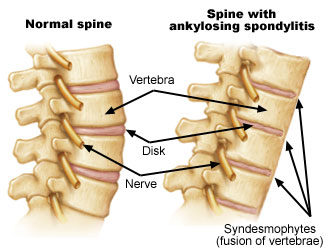Ankylosing Spondylitis Information
Click here to scroll to the list of available medications ↓
Ankylosing spondylitis is a form of inflammatory arthritis. Typically it attacks the joints that link the vertebrates of the spine and the sacroiliac joints, the joints that link the spine and the pelvis. It has been known to migrate to other parts of the body, including the site of attachment for ligaments and tendons to bone, the joints between the ribs and the spine, the joints that run in the hips, feet, shoulders, and knees, and even sometimes the eyes. The inflammation caused by ankylosing spondylitis irritates the area enough that new bony growth develops, causing outcrops of bone in areas that it doesn’t belong, which can be very painful. The bony growths often fuse areas together, creating solid bone rather than a point of flexion. This can lead to difficulty breathing and reduced oxygen capacity as the rib cage fuses, rendering the lungs less useful as the rib cage refuses to yield and expand to incoming air. This chronic condition can lead to deformity and severe pain and loss of quality of life. Therapies are designed to help eliminate these potential secondary conditions.
Ankylosing spondylitis is a condition that morphs over time. Symptoms will change depending on the condition’s state, rate of formation, and may waiver in intensity from time to time. Patients often feel like they are getting better one month only to feel like they have worsened the next. Early symptoms include pain and stiffness in the lower back or hips that often worsens after a night of sleep or after significant periods of inactivity. Stiffness and pain are likely to migrate as the disease progresses, often affecting the entire back and even the neck. When patients begin experience the same pain and stiffness in other, unrelated joints, it is typically a sign that the disease has spread to other areas of the body.
During more advanced stages of the disease, patients may experience chronic stooping, an inability to flex the spine, fatigue, restricted ability to take a deep breath and expand the chest, weight loss usually accompanied by a lack of appetite, bowel inflammation and other bowel problems, and eye inflammation.
There is no known cause of ankylosing spondylitis. In some cases, a genetic issue might lead to an answer. Patients with the gene known as HLA- B27 seem to have a substantially higher risk than those without the gene.

The most noticeable risk factor for the development of ankylosing spondylitis is in the genes. Those with the gene, those under 40 years old with a relative with the disease, and those with other bone issues like early onset osteoporosis may develop the disease. However, those who are over 40 with a family member already diagnosed with ankylosing spondylitis are at a decreased chance of developing the disease. Every year that passes without the development of the disease, the likelihood diminishes even more.
Diagnosis often takes several trips to sometimes numerous physicians. In the early stages of the disease, the chief complaint is back pain and stiffness, which can be caused by anything from mild strains to sleeping on a poor quality mattress. In any case, it may take awhile for the cause of the back pain (the number one health problem in the United States) to be linked to anything serious until the disease has progressed and there are additional symptoms to report.
X-rays and additional imaging processes may help to determine the cause of the discomfort. Blood tests can sometimes help reveal the source of inflammation, although not always. Once the disease has begun to develop to the point of bony growths and deformations, it becomes obvious which disease the physicians and the victim are dealing with. Unfortunately at this time, it takes that long before a definitive diagnosis can be rendered. Many patients are misdiagnosed for several years with other less serious ailments.
The complications which are likely to set in from ankylosing spondylitis are life affecting and can even cause loss of the quality of one’s life. Difficulty walking and standing are common, as is difficulty breathing. Lung infections and heart problems usually follow after a patient has begun to decline their ability to walk effectively without support.
There are a host of medications that can help alleviate the symptoms associated with this disease. Unfortunately, none of the medications will offer a cure. In most instances, patients and physicians work to find a combination of drugs that help to deal with symptoms and manage pain. Corticosteroids are often prescribed for flare ups, either orally or via injection, NSAID pain relievers, and disease modifying antirheumatic medications are the most common forms of treatment.